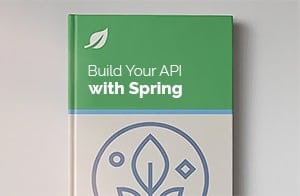1. Overview
Jersey is an open source framework for developing RESTFul Web Services. It also has great inbuilt client capabilities.
In this quick tutorial, we will explore the creation of JAX-RS client using Jersey 2.
For a discussion on the creation of RESTful Web Services using Jersey, please refer to this article.
Building Restful Web Services using Jersey 2 and Spring.
Learn how to implement Cross-Origin Resource Sharing (CORS) mechanism in JAX-RS based applications.
Take a look at how filters and interceptors work in the Jersey framework.
2. Maven Dependencies
Let’s begin by adding the required dependencies (for Jersey JAX-RS client) in the pom.xml:
<dependency>
<groupId>org.glassfish.jersey.core</groupId>
<artifactId>jersey-client</artifactId>
<version>2.25.1</version>
</dependency>
To use Jackson 2.x as JSON provider:
<dependency>
<groupId>org.glassfish.jersey.media</groupId>
<artifactId>jersey-media-json-jackson</artifactId>
<version>2.25.1</version>
</dependency>
The latest version of these dependencies can be found at jersey-client and jersey-media-json-jackson.
3. RESTFul Client in Jersey
We will develop a JAX-RS client to consume the JSON and XML REST APIs that we developed here (we need to make sure that the service is deployed and the URL is accessible).
3.1. Resource Representation Class
Let’s have a look at the resource representation class:
@XmlRootElement
public class Employee {
private int id;
private String firstName;
// standard getters and setters
}
JAXB annotations like @XmlRootElement are required only if XML support is needed.
3.2. Creating an Instance of a Client
The first thing we need is an instance of a Client:
Client client = ClientBuilder.newClient();
3.3. Creating a WebTarget
Once we have the Client instance, we can create a WebTarget using the URI of the targeted web resource:
WebTarget webTarget
= client.target("http://localhost:8082/spring-jersey");
Using WebTarget, we can define a path to a specific resource:
WebTarget employeeWebTarget
= webTarget.path("resources/employees");
3.4. Building an HTTP Request Invocation
An invocation builder instance is created one of the WebTarget.request() methods:
Invocation.Builder invocationBuilder
= employeeWebTarget.request(MediaType.APPLICATION_JSON);
For XML format, MediaType.APPLICATION_XML can be used.
3.5. Invoking HTTP Requests
Invoking HTTP GET:
Response response
= invocationBuilder.get(Employee.class);
Invoking HTTP POST:
Response response
= invocationBuilder
.post(Entity.entity(employee, MediaType.APPLICATION_JSON);
3.6. Sample REST Client
Let’s begin writing a simple REST client. The getJsonEmployee() method retrieves an Employee object based on the employee id. The JSON returned by the REST Web Service is deserialized to the Employee object before returning.
Using the JAX-RS API fluently to create web target, invocation builder and invoking a GET HTTP request:
public class RestClient {
private static final String REST_URI
= "http://localhost:8082/spring-jersey/resources/employees";
private Client client = ClientBuilder.newClient();
public Employee getJsonEmployee(int id) {
return client
.target(REST_URI)
.path(String.valueOf(id))
.request(MediaType.APPLICATION_JSON)
.get(Employee.class);
}
//...
}
Let’s now add a method for POST HTTP request. The createJsonEmployee() method creates an Employee by invoking the REST Web Service for Employee creation. The client API internally serializes the Employee object to JSON before invoking the HTTP POST method:
public Response createJsonEmployee(Employee emp) {
return client
.target(REST_URI)
.request(MediaType.APPLICATION_JSON)
.post(Entity.entity(emp, MediaType.APPLICATION_JSON));
}
4. Testing the Client
Let’s test our client with JUnit:
public class JerseyClientLiveTest {
public static final int HTTP_CREATED = 201;
private RestClient client = new RestClient();
@Test
public void givenCorrectObject_whenCorrectJsonRequest_thenResponseCodeCreated() {
Employee emp = new Employee(6, "Johny");
Response response = client.createJsonEmployee(emp);
assertEquals(response.getStatus(), HTTP_CREATED);
}
}
5. Conclusion
In this article, we have introduced JAX-RS client using Jersey 2 and developed a simple RESTFul Java client.
As always, the full source code is available in this Github project.







